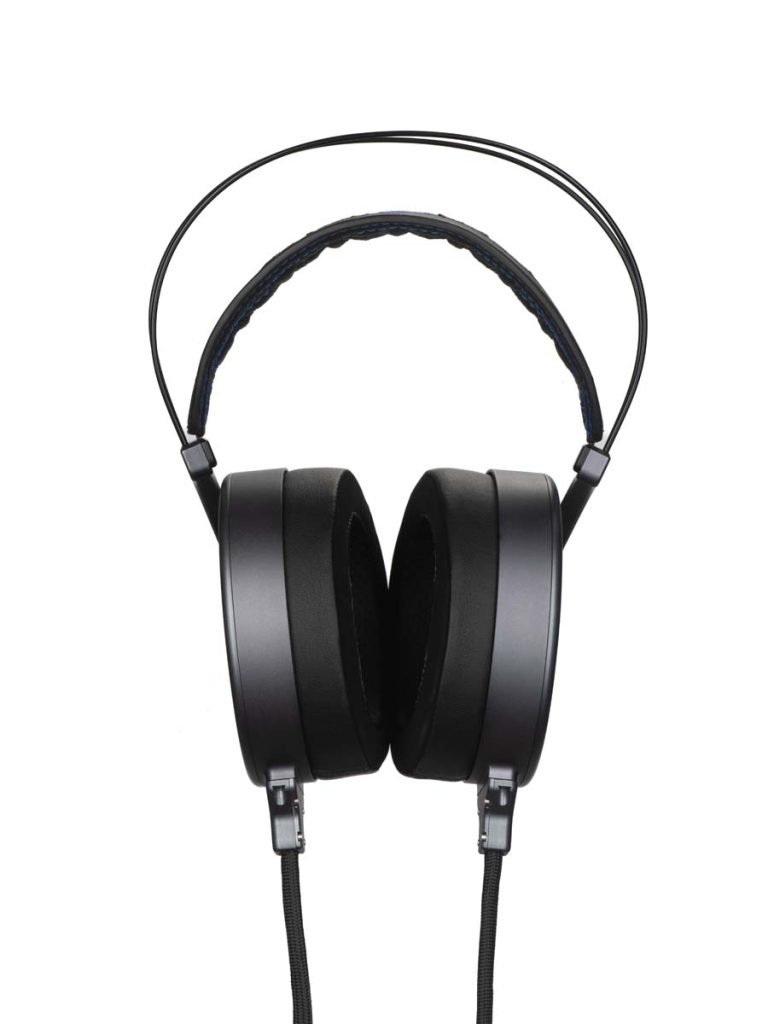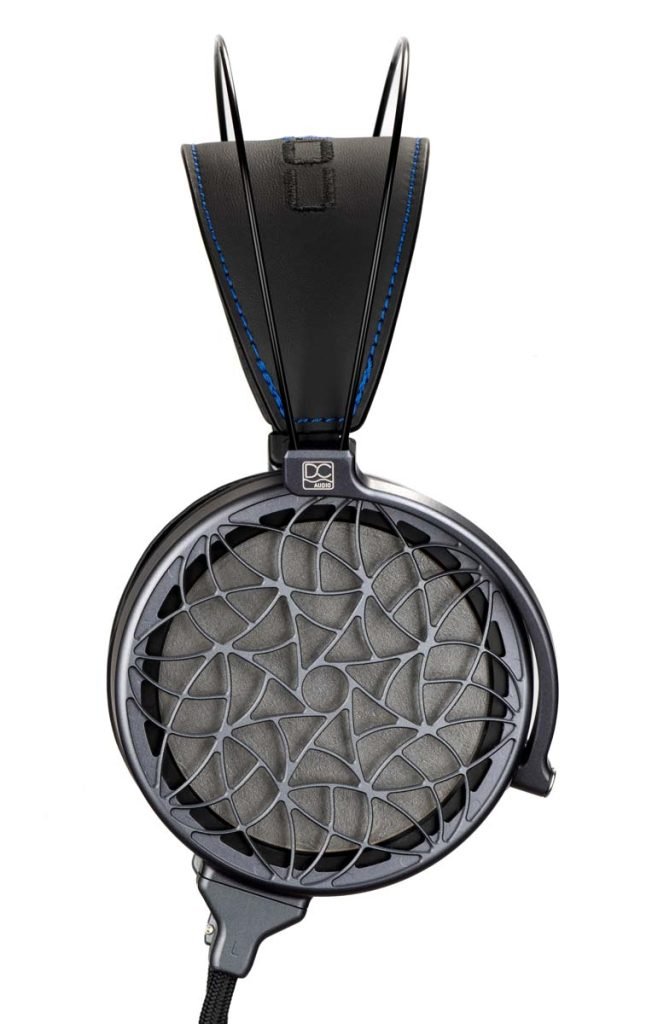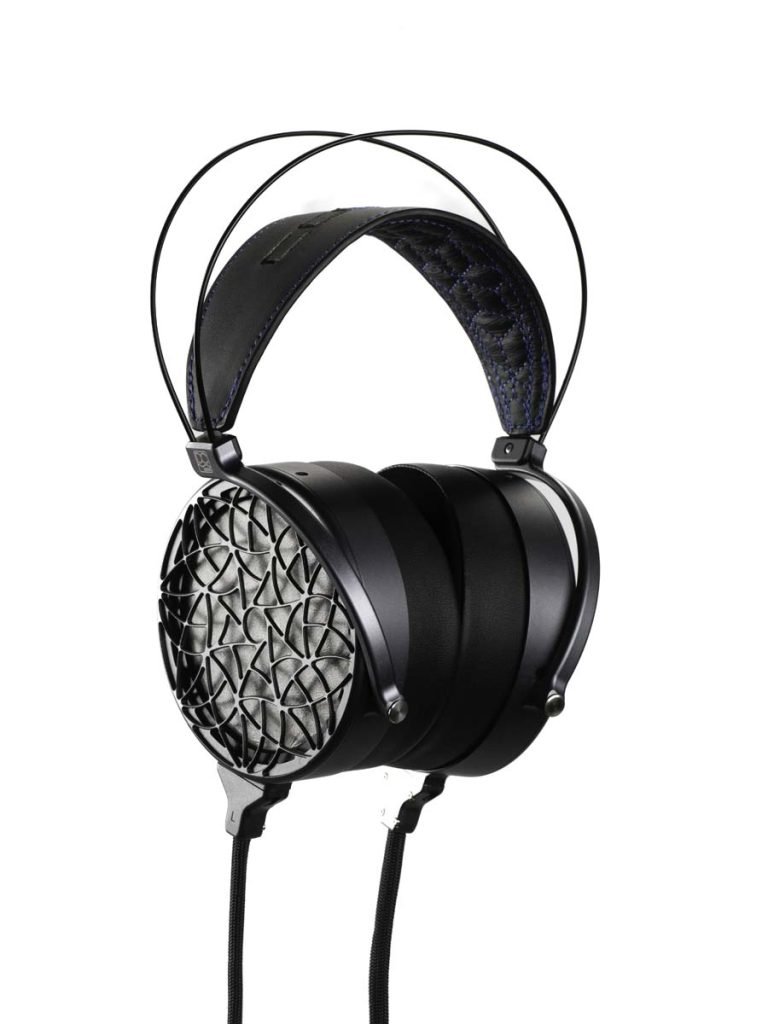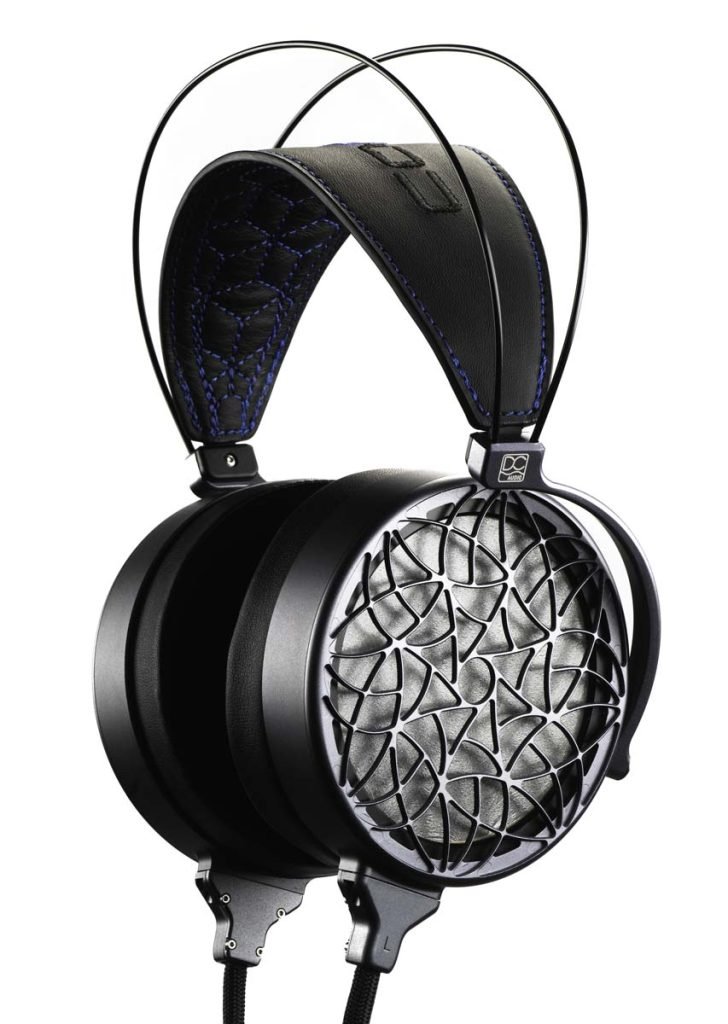DAN CLARK AUDIO CORINA ELECTROSTATIC HEADPHONE REVIEW
Dan Clark Audio Corina electrostatic headphones are at the top end of the head-fi marketplace given their price of nearly £5000. Janine Elliot takes a listen for HiFi PiG
I have to say I have been an avid Stax fan for many, many years, owning as I do an SR-407 ear-speaker and SRM-006tS charger/amplifier. The sound can be amazing when connected to vinyl or balanced all the way from my Krell KPS20i CD player. The sound perhaps just slightly lacks clarity in the bass end, and the tops, whilst pin-sharp, can be a bit tizzy with certain types of music. To be sent the new Corina from Dan Clark Audio (previously known as MrSpeakers) was going to be a chance to see just how good electrostatics can be.

Corina is a premium headphone and everything about them brings this to the fore
The Corina is not trying to be a Stax, this is a product in its own right, and whilst I wanted to hear how different it is, I was quite surprised just how musical it turned out to be. I had heard Stax’s own top-of-the-range model SR-X9000 at a recent HiFi show, so this would be good to compare all three. The Corina is DCA’s second electrostatic headphone, replacing the VOCE from 2018. The word Corina in Spanish means “beloved or dear” (I don’t think the latter refers to the price) and in Greek is derived from word “Korē,” which means maiden or daughter, and this young lady comes in at £4800.
Dan Clark Audio began as Mr Speakers in 2012, and the company has had a number of world-leading designs over that time, some I have reviewed. Dan changed the name of the company in 2019 and this Californian company based in sunny San Diego has been constantly working to take ear speakers to the next level. Would Corina beat the VOCE?
BUILD AND FEATURES
The Corina certainly has some of the looks of the previous electrostatic headphone, and even the flagship 88mm driver remains, though this is improved. This time the headband is beautiful leather and the side grilles have a better looking and almost art deco design. The model uses the Acoustic Metamaterial Tuning System (AMTS) first seen on the STEALTH headphone. This 3D printed membrane, looking like a beehive, gives improved resolution and sits between the transducer and the ear. This basically is a baffle diffuser acting as a quarter-wave and Helmholtz resonator, which ends up removing standing waves and resonances that are created between driver and ear. Such is the design that it even programs the final frequency response of the drivers, ending up with a smooth but detailed soundstage. The idea is to improve the performance, the diffusion elements reducing standing waves which are common in headphones. I’ve seen the idea of controlling standing waves in a few headphones and earphones in the past, though these were placed between the rear of the driver and the ear cup.
The Corina is definitely better looking than the VOCE with the sculptured grey grille and beautiful blue stitching on the black headband. The headband itself is self-tensioning and the Corina has black suede earpads. This reduces heat and moisture buildup, which leather and leatherette earcups will cause. Despite being 100g heavier than my Stax (Corina coming in at 465gr, and heavier than the VOCE) it is still highly comfortable, allowing me many hours of continued auditioning. A lightweight titanium memory headband arch keeps the weight down, though being metal it does ring if you tap it, which is a problem with most headphones.
The box it arrives in has a particularly nice matt black finish and inside is a cute black plastic display stand for you to place the headphones on when not using them. The cabling is particularly good quality and easily maneuverable (better than Stax’s flat cabling) and can be unscrewed and replaced if you ever had a problem.

A look from the side at the Corina headphones
THE SOUND OF THE DAN CLARK CORINA HEADPHONES
The first thing I noticed was that these are fairly inefficient electrostatics, largely due to the diaphragm having a 0.58mm stator gap. This didn’t cause any problems because the STAX SRM-006tS amplifier had enough grunt left to keep me happy and most of the time volume was kept at 40-60 percent.
I started listening to a few of my favourites as I know them so well, and sources included the Krell CD player, digital FLAC and DSD files, and vinyl tracks.
Kate Bush’s “Prelude” and “Prologue” from ‘Aerial’ are very open and very musical tracks with much-extended bass – not OTT – just right but clearly audible. This was a good start. Similarly, the opening of Sting’s ‘Brand New Day’ is very spacious and has a potent deep bass drone. All good so far. The music of both these albums was spacious, especially the seagulls and noises in Kate’s “Prologue”. Indeed, some of the vocals opened up in a way I hadn’t heard before on cans; more detail but an overall smoother sound.
Eva Cassidy’s “Fields of Gold” is a Sting number, but her version is highly enchanting and excellently recorded. Tops from the guitar were clean and precise with Eva’s voice warm and cosy. The Stax tends to make it less smooth and the tops too bright.
To conclude my listening for deep bass and atmosphere I listened to “The Battle” from The Gladiator movie (The Lyndhurst Orchestra). Bass was extended and very clean, particularly the percussion bursts at 1’ and 4’. Top ends were equally extended; everything was clean, though the music was more relaxed than through the Stax. The music was very precise and ‘exact’. Everything was put in the right place and with excellent depth to the music as well as excellent left/right soundstage. Whilst the bass is good on the Corina, extremely low frequencies on an organ piece of Bach I played were not so audible.
“Legends” from Sacred Spirit is great on headphones with the precise and wide left and right balance of instruments. This electronica was cleanly defined and the metal guitar was fun. Any regular reader will know I am a David Bowie fan, and I think his ‘Heathen’ album is his best. At 3’44” on “Sunday” the melancholy atmosphere is interrupted by a great bass rhythm that gets your feet tapping and your interest up a notch or three to the end of the movement. That bass was again very good, but the vocals were particularly pleasing, just as I had experienced with Eva Cassidy. The guitars and hi-hat in “Cactus” were less prickly than my Stax, but still with lots of detail and extension of frequencies. That top end was so well controlled and musical, and again not as bright as the Stax, which as a much cheaper ear-speaker just doesn’t have the same musicality. These were excellent headphones with plenty of top-end detail, but just not as tizzy as I was used to; everything was smoother and warmer, but not taking away any of the beauty and detail of the music.
The Dixie Dregs version of the iconic Led Zeppelin “Kashmir” had such tight drums and clearer tops from the cymbals without the tizz and nasal sound of the Stax. Similarly, Dr John’s “Season of the Witch” top end was more defined in the soundstage giving a 4K performance to the music.
On vinyl, Ultravox’s reissued 180g ‘Vienna’ album starts with a repeated digital beat in this instrumental first track, only to be joined later with bass and synths. There is plenty of top-end and all frequencies were clear and very atmospheric. “Mr X” has lots of electronics with a clearly defined deep spoken voice that spread beautifully with an echo effect across the soundstage. Often this can sound confused, but the Corinas were very much in control. Of course, I had to play the title track “Vienna”. Whilst the bass wasn’t extended any further than I am used to, it just sounded clearer. The synths seemed more musical and vocals and piano were highly infectious. Everything was just so much more clear between my ears, I guess largely due to the AMTS. The digital violin/cello was highly engrossing, though no headphone – no matter how good – would ever turn it into a real instrument, though the Corina did try. Everything was spaced out perfectly in the soundstage and the tops were clearer and more realistic than I have heard before.
Turning to jazz I played Thelonius Monk’s ‘Live in Rotterdam 1967’. This is a mono album but that didn’t stop my enjoyment of these headphones. Mono can often sound slow and boring to me, but the Corinas gave a very faithful and tidy performance that kept me engrossed for longer than I expected.
Sibelius’ 2nd symphony from the Berliner Philharmoniker conducted by Simon Rattle has a well-known opening to get the listener ready for what is an epic and well-known movement. But it was the second movement I wanted to listen to today. It begins with pizzicato cellos which Corina timed beautifully with plenty of atmosphere. As the movement took hold, I was highly engrossed by the soundstage, not just left/right but even the depth of the music. As the Corina has angled AMTS membranes it means sound also hits your ears at an angle and therefore much more naturally.
All the classical music I played just sounded so musical that I didn’t want to put these ear speakers down.
Finally, Purcell’s Chacony in G minor (Orpheus Chamber Orchestra, DG) was particularly gentle on the ear though even the harpsichord was pinpoint accurate. These headphones worked better for me on classical music.
CONCLUSION
If you want a tizzy and OTT top end then don’t look at the DCA, and if you want a Stax sound then you similarly need to look elsewhere. Everything on the Corina is so well-controlled and musical that within a few minutes I just didn’t want to take these headphones off my head.
The tops are still there, only they are as they should be listened to and not blaring out into your head. Similarly, the mid band is smoother and much more musical than I have heard from any headphone.
You might need to turn the wick up a little to get the best volume but these are such damn good transducers of music and speech that I think Dan Clark has got a winner here and worth the extra price over the previous Dan Clark high-end cans I have tried.
AT A GLANCE
Build Quality:
Expertly assembled and looking very expensive
Sound Quality:
Exceptionally musical performance particularly mids and tops, and working with all types of music, though I preferred vocal and classical
Value For Money:
£4800 is not cheap for ear speakers, especially when you also need a Stax or equivalent 580V pro bias amp to get them working, but for the performance you get they are certainly stiff competition to Stax
We Loved:
Excellent soundstage
Mid-frequency detail
Transparency at the top and no tizz in sight
We Didn’t Love So Much
Some may find the controlled and gentler top end not what they are used to
Elevator Pitch Review: I always enjoy reviewing products from Dan Clark Audio. His headphones never fail to give detail and warmth which makes for a very musical listen. The new Corina electrostatic headphone was no exception, and quite different to the Stax ear-speakers I am accustomed to.
Price: £4800

Janine Elliot
Pre-Audio GL-1102N/Audio Technica AT33sa (turntable/cartridge); Manley Steelhead (phono stage); Krell KPS20i (CD); Astell and Kern SE180/iFi xDSD (DAP/streamer); Stax SRM-006tS charger/amplifier.
Specification
Driver size; 88mm 2.4micron thick diaphragm
Capacitance; with cable 135 pF
Cable; 2m silver plated copper
Titanium Memory metal headband and auto adjusting suspended comfort strap.
Weight; 465g

















































































































































































































